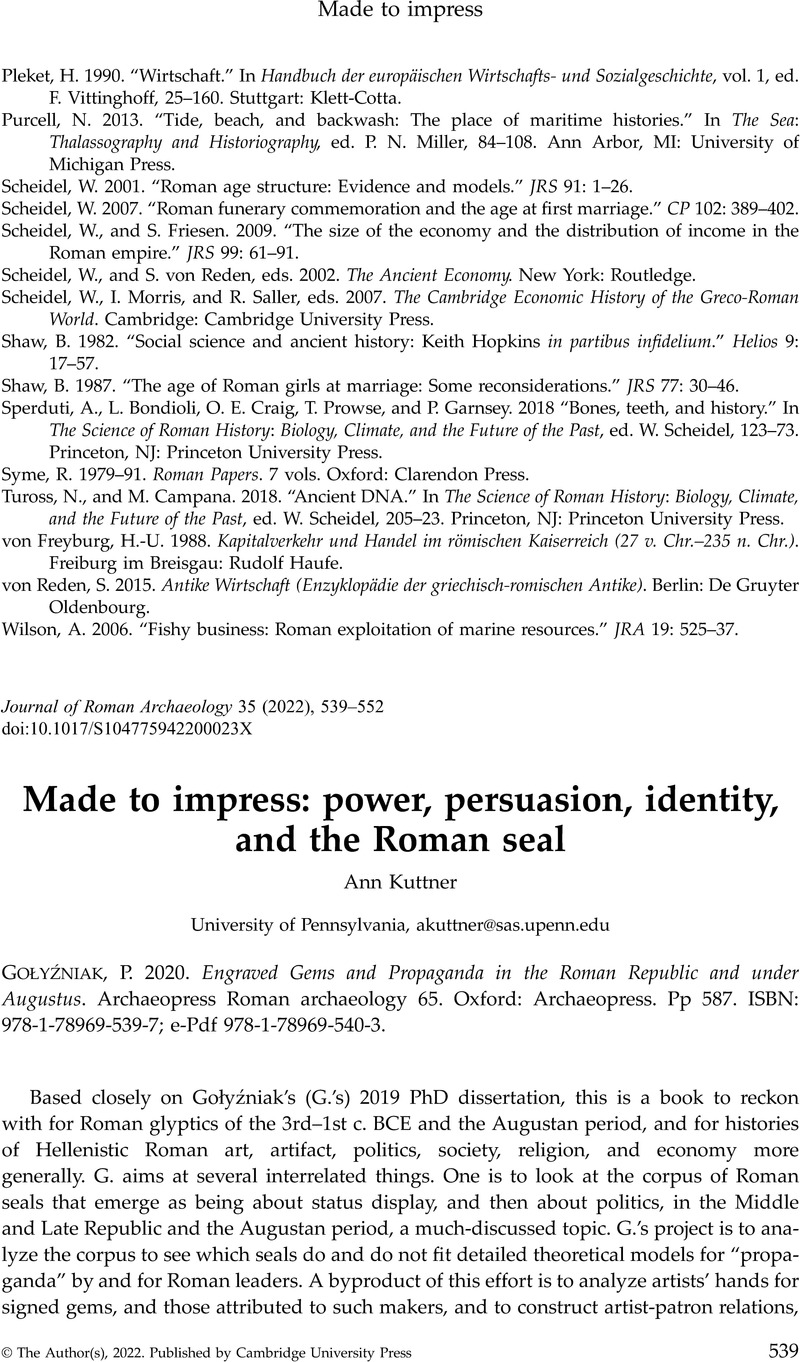No CrossRef data available.
Article contents
Made to impress: power, persuasion, identity, and the Roman seal - P. Gołyźniak 2020. Engraved Gems and Propaganda in the Roman Republic and under Augustus. Archaeopress Roman archaeology 65. Oxford: Archaeopress. Pp 587. ISBN: 978-1-78969-539-7; e-Pdf 978-1-78969-540-3.
Review products
P. Gołyźniak 2020. Engraved Gems and Propaganda in the Roman Republic and under Augustus. Archaeopress Roman archaeology 65. Oxford: Archaeopress. Pp 587. ISBN: 978-1-78969-539-7; e-Pdf 978-1-78969-540-3.
Published online by Cambridge University Press: 06 July 2022
Abstract
An abstract is not available for this content so a preview has been provided. Please use the Get access link above for information on how to access this content.

- Type
- Book Review
- Information
- Copyright
- Copyright © The Author(s), 2022. Published by Cambridge University Press
References
Casagrande-Kim, R. 2018. “Dactyliothecae Romanae: Collecting gems in ancient Rome.” In Collecting and Collectors from Antiquity to Modernity, ed. Carpino, A., D'Angelo, T., Muratov, M., and Saunders, D., 99–112. Selected Papers on Ancient Art and Architecture 4. Boston: Archaeological Institute of America.Google Scholar
D'Ambrosio, A., and De Carolis, E., eds. 1997. I monili dall’ area vesuviana. Ministero per i beni culturale e ambientali, Soprintendenza archeologica di Pompei, Cataloghi 6. Rome: L'Erma di Bretschneider.Google Scholar
Dubois-Pélerin, E. 2008. Le luxe privé à Rome et en Italie au Ier siècle après J.-C. Naples: Publications du Centre Jean Bérard. https://books.openedition.org/pcjb/3007.CrossRefGoogle Scholar
Ellis, S. 2018. The Roman Retail Revolution: The Socio-Economic World of the Taberna. Oxford: Oxford University Press.CrossRefGoogle Scholar
Gahtan, M., and Pegazzano, D., eds. 2015. Museum Archetypes and Collecting in the Ancient World. Leiden: Brill.CrossRefGoogle Scholar
Horn, H. G., and Rüger, C., eds. 1979. Die Numider. Reiter und Könige nördlich der Sahara. Kunst und Altertum am Rhein 96. Cologne: Rheinland-Verlag.Google Scholar
Kinney, D. 2011. “Ancient gems in the Middle Ages: Riches and ready-mades.” In Reuse Value: Spolia and Appropriation in Art and Architecture from Constantine to Sherrie Levine, ed. Brilliant, R. and Kinney, D., 97–120. Farnham and Burlington: Ashgate.Google Scholar
Marlowe, E. 2013. Shaky Ground: Context, Connoisseurship and the History of Roman Art. London: Bloomsbury Academic.Google Scholar
Marshman, I. 2015. “Making Your Mark in Britannia: An Investigation into the Use of Signet Rings and Intaglios in Roman Britain.“ Ph.D. diss., University of Leicester.Google Scholar
Marshman, I. 2017. “All that glitters: Roman signet rings, the senses and the self.” In Senses of the Empire: Multisensory Approaches to Roman Culture, ed. Betts, E., 136–46. Abingdon and New York: Routledge.Google Scholar
Newby, Z. 2016. Greek Myths in Roman Art and Culture: Imagery, Values and Identity in Italy, 50 BC–AD 250. Cambridge and New York: Cambridge University Press.CrossRefGoogle Scholar
Ostenberg, I. 2009. Staging the World: Spoils, Captives, and Representations in the Roman Triumphal Procession. Oxford: Oxford University Press.CrossRefGoogle Scholar
Platt, V. 2006. “Making an impression: Replication and the ontology of the Graeco-Roman sealstone.” Art History 29: 233–57.CrossRefGoogle Scholar
Platz-Horster, G. 2009. “Die antiken Gemmen aus Xanten Teil III: Neufunde, Neuerwerbungen, Nachträge und Auswertung.” In Xantener Berichte 15: Grabung - Forschung - Präsentation, ed. Müller, M., 129–82. Mainz: Von Zabern.Google Scholar
Richter, G. 1920. Catalogue of the Engraved Gems of the Classical Style. New York: Metropolitan Museum of Art.Google Scholar
Richter, G. 1956. Catalogue of the Engraved Gems: Greek, Etruscan and Roman. Rome: “L'Erma” di Bretschneider.Google Scholar
Richter, G. 1971. Engraved Gems of the Greeks, Etruscans and Romans. Vol. 2. Engraved Gems of the Romans. London: Phaidon.Google Scholar
Roller, D. 2003. The World of Juba II and Kleopatra Selene: Royal Scholarship on Rome's African Frontier. New York: Routledge.Google Scholar
Roller, D. 2015. Ancient Geography: The Discovery of the World in Classical Greece and Rome. London: I. B. Tauris.CrossRefGoogle Scholar
Rose, C. B. 2008. “Forging identity in the Roman Republic: Trojan ancestry and veristic portraiture.” In Role Models in the Roman World: Identity and Assimilation, ed. Bell, S. and Hansen, I. L., 97–132. Ann Arbor: University of Michigan Press.Google Scholar
Sgobbo, I. 1977. “Il maggior tempio del foro di Cuma e la munificenza degli Heii cumani in epoca sannitica.” RAAN n.s. 52: 231–64.Google Scholar
Sodo, A. M. 1992. “Gemme dalla casa del Gemmario di Pompei.” In Bellezza e lusso. Immagini e documenti di piaceri della vita: Roma, Castel Sant'Angelo, 31 marzo-14 aprile 1992, ed. Cappelli, R., 89–91. Rome: Leonardo - De Luca.Google Scholar
Thoresen, L. 2017. “Archaeogemmology and ancient literary sources on gems and their origins.” In Gemstones in the First Millennium AD: Mines, Trade, Workshops and Symbolism. International Conference, October 20th - 22nd, 2015. Römisch-Germanisches Zentralmuseum, Mainz, ed. Hilgner, A., Greiff, S., and Quast, D., 155–218. Mainz: Römisch-Germanischen Zentralmuseum.Google Scholar
Wagner, C. 2019. “Studying gems: Collectors and scholars.” In Greek Art in Motion: Studies in Honour of Sir John Boardman on the Occasion of his 90th Birthday, ed. Morais, R., Leão, D., and Rodriguez Pérez, D., 37–45. Oxford: Archaeopress.CrossRefGoogle Scholar
Yarrow, L. 2018. “Markers of identity for non-elite Romans: A prolegomenon to the study of glass paste intaglios.” Journal of Ancient History and Archaeology 5, no. 3: 35–54. http://jaha.org.ro/index.php/JAHA/article/view/326.Google Scholar
Zwierlein-Diehl, E. 1986. Glaspasten in Martin-von-Wagner-Museum der Universität Würzburg. Vol. 1. Abdrücke von antiken und ausgwählten nachantiken Intagli und Kameen. Munich: Prestel Verlag.Google Scholar
Zwierlein-Diehl, E. 2007. Antike Gemmen und ihr Nachleben. Berlin and New York: De Gruyter.Google Scholar


